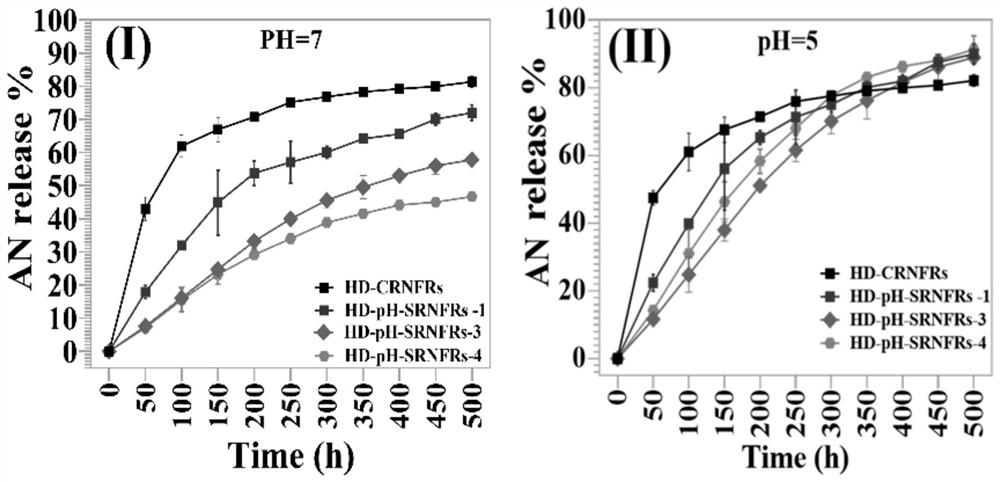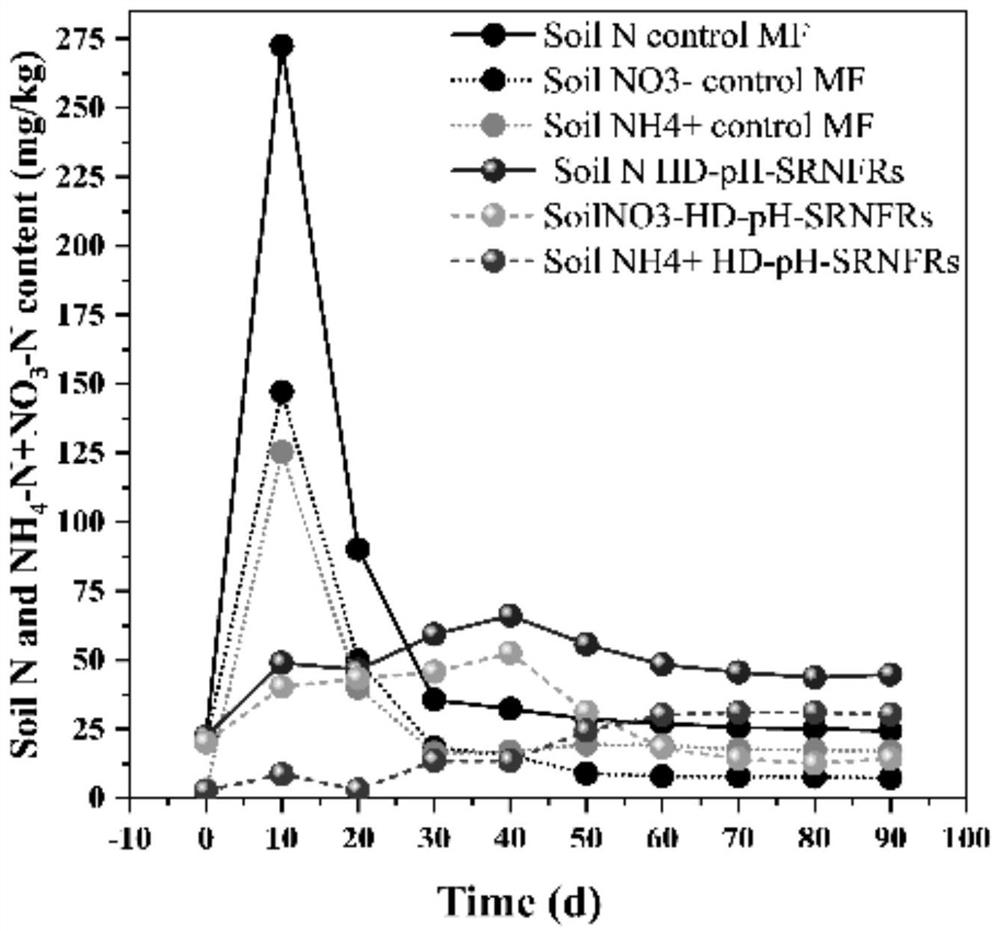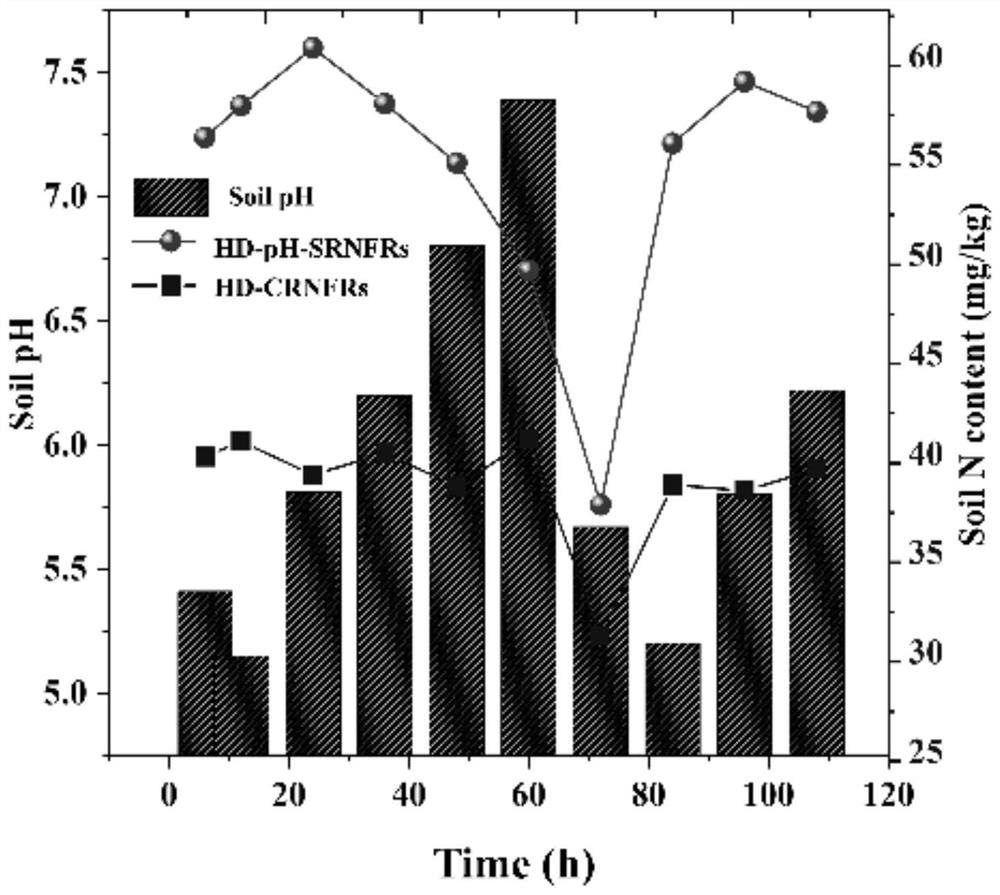Preparation method of degradable pH-responsive nano cellulose-based hydrogel slow-release fertilizer
A technology of nanocellulose and nanofibers, applied in application, nitrogen fertilizer, fertilization equipment, etc., can solve the problem that mainstream hydrogels are difficult to be degraded by microorganisms
- Summary
- Abstract
- Description
- Claims
- Application Information
AI Technical Summary
Problems solved by technology
Method used
Image
Examples
Embodiment 1
[0034]The wheat straw powder is first activated by an air plasma instrument, wherein the voltage of the equipment is 50V, the frequency is 20-25kHz, and the flow rate is 1L / min; sodium oxide and 15wt% hydrogen peroxide) for 2 hours, then washed with distilled water and dried to obtain cellulose fiber powder. Weigh 0.075g TEMPO (2,2,6,6-tetramethylpiperidinium oxide), 0.5g sodium bromide in a 1000mL three-neck flask containing 500ml deionized water and stir to dissolve, add 5g cellulose fiber powder, 0.2mol / L HCl to adjust the pH value of sodium hypochlorite (available chlorine 12%, 5mmol / g) solution to about 10, and slowly add 28.5ml of sodium hypochlorite solution dropwise into the flask, while adjusting the pH value with 0.4mol / L NaOH The pH of the reaction system is maintained at about 10. After the sodium hypochlorite solution is dripped within 3 hours, continue to stir until the pH does not change significantly to obtain the oxidized matrix, and then use a high-speed shea...
Embodiment 2
[0036] Weigh 10 g of acrylamide, 0.5 g of 2-aminoethyl methacrylate hydrochloride, 0.45 g of amino-functionalized nanocellulose, 2.7 g of ammonium nitrate solution (concentration 8 mg / mL) and 10 mg of cross-linking agent N,N -Methylenebisacrylamide, stirring and mixing; under the protection of nitrogen, add initiator potassium persulfate (3.2mg) and 2-2'-azobis-(2-2-ylpropane hydrochloride) ( 8.14mg), and 0.045ml of catalyst 1,2-bis(dimethylamino)ethane; then pour the mixed solution into a PVA (polyvinyl alcohol) template, and copolymerize it at 40°C for 12h to obtain A granular hydrogel with a diameter of 1.4 cm; the resulting hydrogel was washed 3 times with distilled water to remove unreacted monomers in the hydrogel, and then the hydrogel was dried in an oven at 30°C for 12 hours, A degradable pH-responsive nanocellulose-based hydrogel slow-release fertilizer is obtained.
Embodiment 3
[0038] Weigh 10 g of acrylamide, 1.0 g of 2-aminoethyl methacrylate hydrochloride, 0.45 g of amino-functionalized nanocellulose, 2.9 g of ammonium nitrate solution (concentration 8 mg / mL) and 10 mg of cross-linking agent N,N -Methylenebisacrylamide, stirring and mixing; under the protection of nitrogen, add initiator potassium persulfate (3.2mg) and 2-2'-azobis-(2-2-ylpropane hydrochloride) ( 8.14mg), and 0.045ml of catalyst 1,2-bis(dimethylamino)ethane; then pour the mixed solution into a PVA (polyvinyl alcohol) template, and copolymerize it at 40°C for 12h to obtain A granular hydrogel with a diameter of 1.4 cm; the resulting hydrogel was washed 3 times with distilled water to remove unreacted monomers in the hydrogel, and then the hydrogel was dried in an oven at 30°C for 12 hours, A degradable pH-responsive nanocellulose-based hydrogel slow-release fertilizer is obtained.
PUM
| Property | Measurement | Unit |
|---|---|---|
| Diameter | aaaaa | aaaaa |
Abstract
Description
Claims
Application Information
 Login to View More
Login to View More - R&D
- Intellectual Property
- Life Sciences
- Materials
- Tech Scout
- Unparalleled Data Quality
- Higher Quality Content
- 60% Fewer Hallucinations
Browse by: Latest US Patents, China's latest patents, Technical Efficacy Thesaurus, Application Domain, Technology Topic, Popular Technical Reports.
© 2025 PatSnap. All rights reserved.Legal|Privacy policy|Modern Slavery Act Transparency Statement|Sitemap|About US| Contact US: help@patsnap.com



